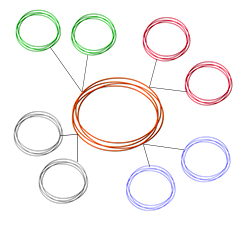Responsible use of Internet resources

One of the aspects where we need to think and train our students is in the proper use of resources found on the Internet, respect for authors and the types of license with which they are published.
The widespread use of the Internet to search for information and the ease with which text, images, music and videos are found, may lead you to assume that they are free of copyright and may be reproduced, modified and republished online in work projects that pupils are asked to carry out.
As soon as the Internet is used as a classroom resource for conducting activities, it is necessary for our pupils to be aware that accessibility to any resource does not imply freedom of use, as the contents found on the Internet generally have some kind of license and an author who must be given proper credit for the work they have done
There are two small actions that will help prevent potential fraudulent use of materials taken from the Internet, and which we must get used to in the educational community, one being to check the type of license that the resource has, which may be so closed that they have copyright preventing their reproduction in any context without the express permission of the author, or so open that they are published as copyleft, which allows the use, reproduction, modification and distribution of the resource, provided that the same conditions of use are maintained. Between them there are several types of licenses that are more or less restrictive. Knowing the type of license will prevent subsequent trouble
In eTwinning projects it is requested that images and sounds used should comply with the requirement of having a license allowing its use for these projects, or that they have been produced by the participants in the project.
The second action that will help respect the rights of the author is the recognition of the work done. Any resource you decide to use, once it is confirmed that it has been published under a license that permits this, must document who the author of that material is, indicating it in the right place: beneath an image used to illustrate a text, at the end of a video….
Find the best place to state the author, the web address where it was taken and the date that material was downloaded from the Internet.
But you can also avoid misuse of resources if you use repositories, search engines and platforms that offer their resources free and openly.
We have suggested some areas in which you can find images:
INTEF image Bank: : http://recursostic.educacion.es/bancoimagenes/web
Creativecommons search tool: http://search.creativecommons.org
Flickr’s Creative Commons Free Pictures: https://www.flickr.com/groups/creative_commons-free_pictures
Gratisography: http://gratisography.com
morgueFile: http://www.morguefile.com/archive
Pics4Learning: http://pics.tech4learning.com
Photo5: http://photos5.com
Pixabay: https://pixabay.com/es
In a quick look at eTwinning projects, we could say that most of the videos produced in the projects include music, and in most cases commercial music. So that our pupils can use music in their videos without risking breaking the law, we are proposing some areas where you can find free music and with open licenses:
Freesound: https://freesound.org
Jamendo: https://www.jamendo.com/es/welcome
If you want to dig a little deeper on this issue of reusing resources that can be found on the Internet, I recommend a self-education course that is published on the INTEF website, within the space dedicated to Training, in the open learning materials section: Creation, reuse and distribution of content
Source of the image: http://www.morguefile.com/archive , 15/10/2015. Author pippalou
ICT tools








Reglamento de protección de datos (información básica)
En cumplimiento de la normativa de protección de datos personales, le informamos de que sus datos serán incorporados al tratamiento denominado “eTwinning participación”, cuya finalidad es la participación en el proyecto de colaboración europeo eTwinning.
Puede usted ejercitar los derechos de acceso, rectificación, oposición, supresión (“derecho al olvido”), limitación de tratamiento y portabilidad y a no ser objeto de decisiones individuales automatizadas que sean de aplicación de acuerdo a la base jurídica del tratamiento. Podrá hacerlo en la sede electrónica del ministerio (http://www.educacionyfp.gob.es/servicios-al-ciudadano-mecd/catalogo/educacion/varios/proteccion-datos.html), presencialmente en las oficinas de registro o por correo postal.
Al rellenar y enviar este formulario usted concede su consentimiento inequívoco para el almacenamiento de sus datos en nuestros ficheros tal y como se especifica en nuestras normas de privacidad.
Normas de privacidad
NOMBRE DEL TRATAMIENTO
eTwinning participación.
FINALIDAD
Participación en el proyecto de colaboración europeo eTwinning.
RESPONSABLE
Dirección General de Evaluación y Cooperación Territorial del Ministerio de Educación y Formación Profesional
C/ Alcalá, 34; 28014-MADRID.
DELEGADO DE PROTECCIÓN DE DATOS
Subdirección General de Atención al Ciudadano, Documentación y Publicaciones.
c/ San Agustín 5, 28014-MADRID
dpd@educacion.gob.es
PLAZOS O CRITERIOS DE CONSERVACIÓN DE LOS DATOS
Sus datos se conservarán durante el tiempo necesario para la tramitación y respuesta de su solicitud. Además, será de aplicación lo dispuesto en la normativa de archivos y documentación.
DECISIONES AUTOMATIZADAS
No se realizará toma de decisiones individuales automatizadas basadas en la información que usted nos proporciona.
PLAZOS O CRITERIOS DE CONSERVACIÓN DE LOS DATOS
Sus datos se conservarán durante el tiempo necesario para la tramitación y respuesta de su solicitud. Además, será de aplicación lo dispuesto en la normativa de archivos y documentación.
LEGITIMACIÓN O BASE JURÍDICA DEL TRATAMIENTO
El tratamiento es necesario para el cumplimiento de una obligación legal aplicable al responsable del tratamiento, artículo 6.1e) del RGPD, Reglamento UE 2016/679, y en la Ley 8/2013, de 9 de diciembre, para la mejora de la calidad de la enseñanza.
DESTINATARIOS
Departamentos de Educación de las CC.AA que llevan proyectos europeos, para distintas gestiones, como la tramitación de permisos ausencia del centro, envío de información relevante, etc.
DERECHOS
Puede usted ejercitar los derechos de los artículos 15 al 22 del RGPD que sean de aplicación de acuerdo a la base jurídica del tratamiento. Podrá hacerlo en la sede electrónica del ministerio, presencialmente en las oficinas de registro o por correo postal.
AUTORIDAD DE CONTROL
La autoridad de control en materia de protección de datos personales es la Agencia Española de Protección de Datos (http://www.aepd.es).
CATEGORÍA DE DATOS PERSONALES
Los datos personales que se tratarán son los que figuran en el formulario que usted nos proporciona.